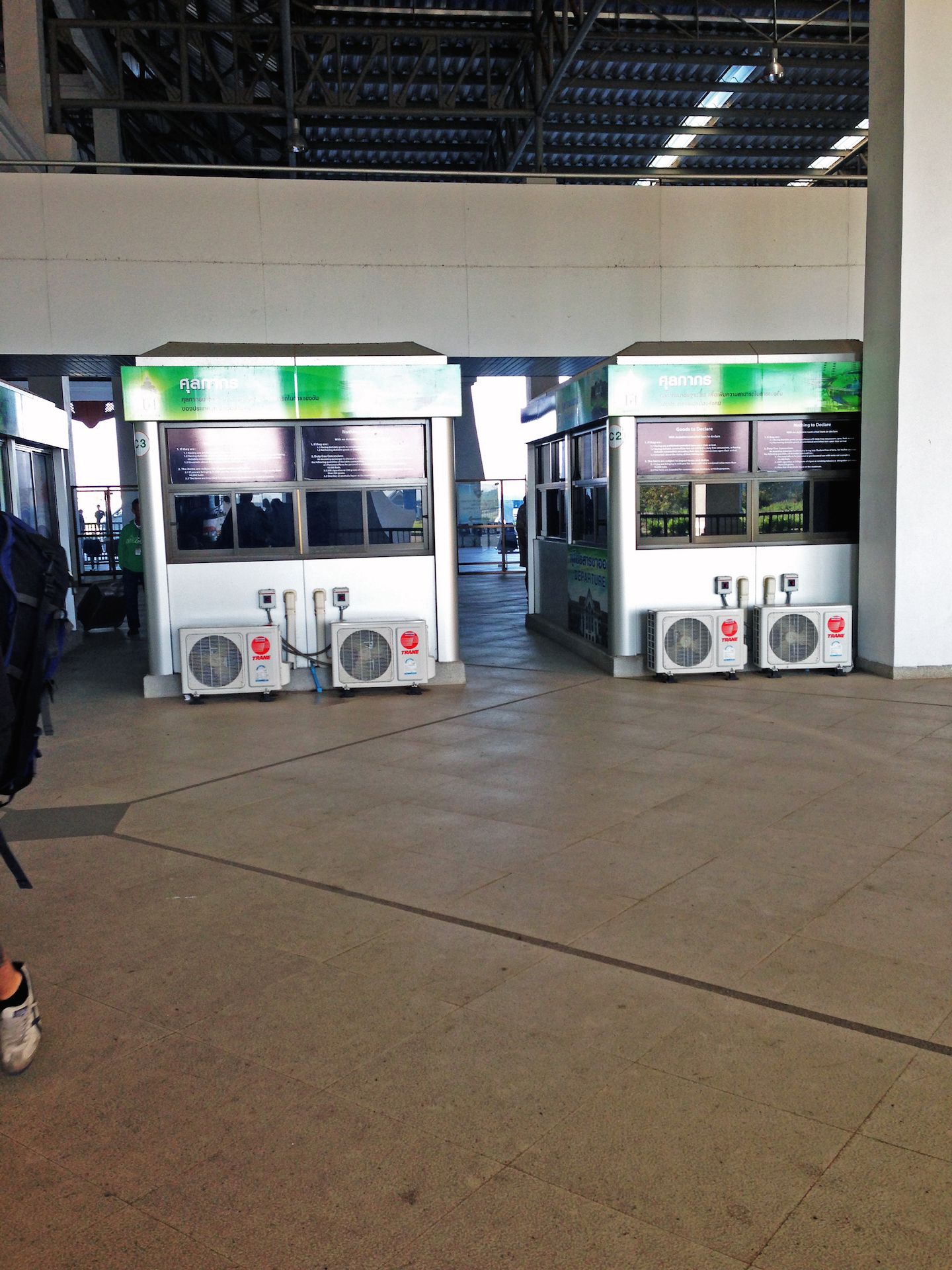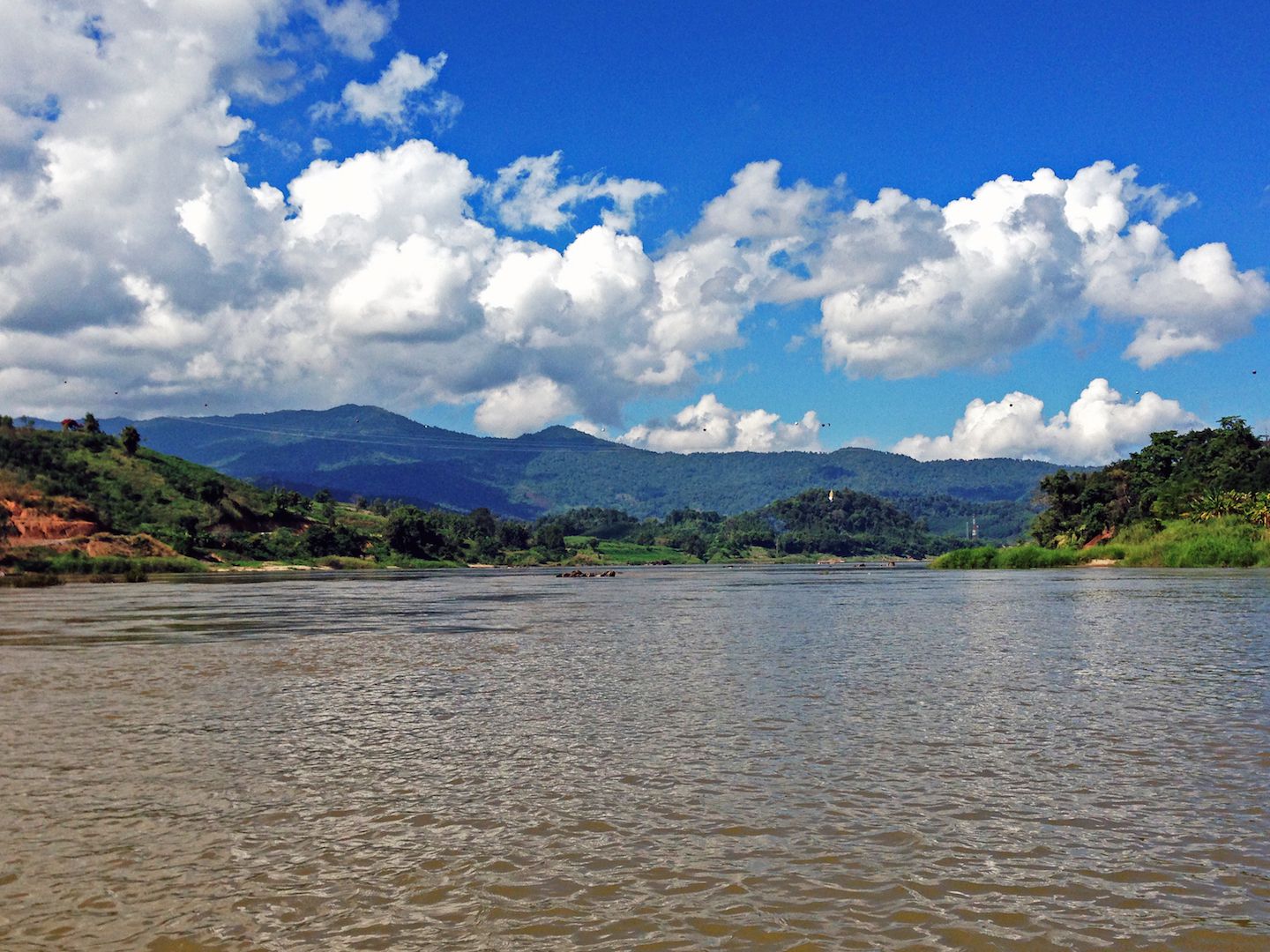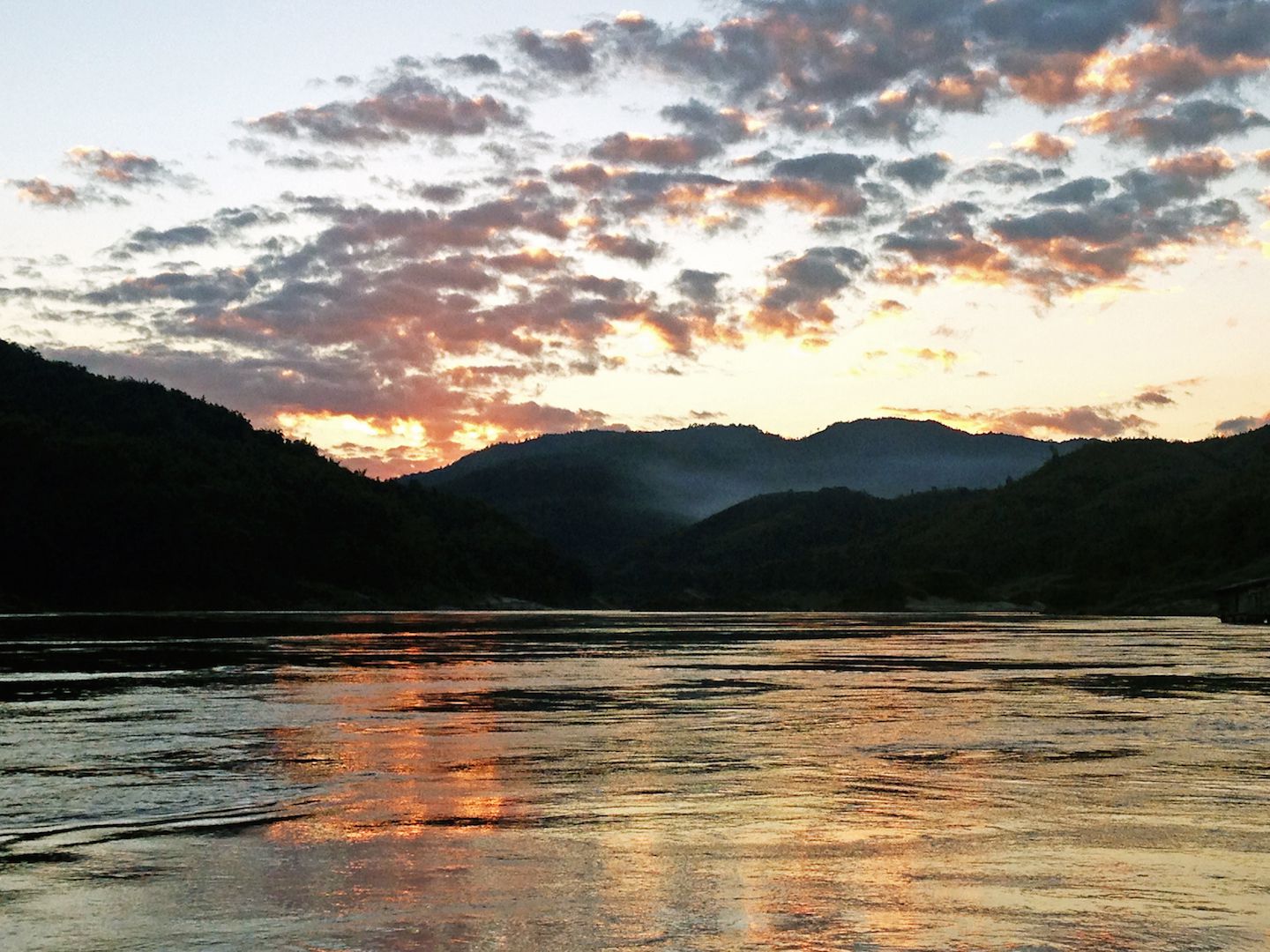Our journey from Thailand to Laos started at 6:30am in the morning in Chiang Rai, where we were taken by minivan to the Chiang Khong border. The driver was reckless, but we appreciated Thai roads one last time because it was about to get way worse on the other side.
Thai-Lao Border at Chiang Khong/Bokeo
We stamped out of Thailand (25 days? It didn’t seem that long) and instead of the usual few hundred meters of walking to the other side, we hopped onto a bus. Special Thai-Lao border buses cross the Thai-Lao Friendship Bridges built for border crossings. This one at the Chiang Khong / Bokeo border was pretty new and we were grateful. A year ago, we would have had to take a ferry and tuk-tuk and climb a hill. So yay for the 4th friendship bridge!
The Lao side was noticeably shabbier than the Thai side. Customs here is supposedly not always open, and charge extra for “late-night” or “holiday” processing. We heard from two girls that they had arrived the night before, handed in their passports, and were told to come back next morning. That must have sucked. There was nothing around – I wonder where they slept?

Visa on arrival at Laos was disorganized as we have come to expect. Two forms and one passport photo plus the passport were handed into a window. By now we know not to stress about not knowing how to fill out certain parts of the form (i.e. name and telephone of contact in Laos? We don’t have one!). We just leave it blank! If they have a problem with it, they will tell us. After waiting for quite some time, we got our passports back in exchange for $42 from me (for some reason it’s the most expensive for Canadians) and $30 from Carlos.

Security at the border was so lax, especially since we’re both so used to the iron gates and secondary questionings at US borders. The whole process took long enough and cost enough for us to wonder about how easy it would’ve been to just get some floating device and cross the river ourselves. Literally the only thing separating Laos and Thailand for much of its border is the Mekong River. Certainly at the Chiang Khong/Bokeo border, the river wasn’t that wide. It would probably only take 10 minutes – no paperwork, no fees, no hassle. But I digress. We should do the right thing and enter each country legally.

Once we were officially in Laos, we boarded a songthaew that was supposed to drive us into Huay Xai, the border town. Our big backpacks were thrown onto the top of the songthaew – we hoped for the best that they wouldn’t fall off during the drive. Instead of the boat pier, we arrived at a random house / office where we had to wait for an hour or so.

A man who spoke somewhat decent English tried to give more information about the boat ride, sell food, and promote his money exchange at the “best rate” (but of course they all say that). We came having done our research and knowing what to expect, so we didn’t need any of his overpriced services. If anything it irked me a bit to hear him tell everyone all kinds of details about the boat. People who take the time and effort to be prepared should be rewarded as compared to those who don’t… though I’m sure he won trust points with what he said, so I understand from a business perspective.

Huay Xai to Luang Prabang
We needed to make our way from Huay Xai to Luang Prabang, our next destination. There were several options:
- Slow Boat
Pros: cheapest and safest option, scenic views, bathroom on board, unique experience
Cons: very slow, two full days including overnight in a town, 6-7 hours per day stuck on the boat - Fast Boat
Pros: fastest option at only 8 hours or so
Cons: expensive, questionably dangerous, very loud and shaky, crammed - Bus
Pros: no need to take a boat, faster than the slow boat at around 24 hours
Cons: windy roads, uncomfortable, no bathroom, mostly locals
Given that we were not in a rush, it’s obvious that slow boat was the best choice. We had bought a ticket for the entire trip in Chiang Rai for 750 baht per person. However, the ticket doesn’t guarantee you good seats on the boat, and we read online that we should get there early to get the best seats. Front to middle of the boat is best, as the engine at the back is loud and it’s also where people go to smoke and pee. We also chose the best side with the least sunlight considering the direction the boat was headed.

2-Day Slow Boat on the Mekong
We thought the boat would be an experience, as we’ve never traveled between places via slow boat before. The boats were very long and narrow, wooden with a metal roof. The boat ride was calm, smooth, kept at a constant cruising speed. Seats were taken from buses, with a central aisle for walking around. There was a nice breeze during the whole ride. A toilet in the back of the boat was super useful (hopefully our fecal matter did not go directly into the river). I never expected this, but it was way better than a crammed bus.

Despite the pleasant experience, it still took 6-7 hours on the boat per day over the course of two days. We filled the idle time with a variety of activities to entertain ourselves. Playing cards, word games, napping, watching movies, listening to music, chatting with other travelers… it felt like we had all the time in the world.

For most of the journey, we felt like we were in an extremely remote part of the world. It was as if our boat was the only thing for miles and miles, while all around us were untouched forests and jungle. I imagine this was what the explorers must have felt like, sailing the rivers of the wilderness. The entire journey was indeed as scenic as many people have described.

It was clear that the Mekong was truly a lifeline for many people in SE Asia. We had visited part of the Mekong Delta in Vietnam, but never like this, cruising down the winding river, wherever it may take us. Occasionally we caught glimpses of a group of houses perched on the side of the river valley. Very primitive settlements, but signs of humans nonetheless. Once in a while we stopped to drop off a local at a village, and all the children waved enthusiastically while we all waved back wondering how on earth they could live so far away from everything else we’ve ever known.

We stopped in Pakbeng overnight – a tiny town with only a few streets. I wouldn’t be surprised if this town was purely built for the boat ride stopover for tourists. I also wouldn’t be surprised if there were more foreigners than locals in Pakbeng. Our 400 baht room was surprisingly nice and clean. I have never seen the moon shine so brightly – we joked that the moon lit up the town more than the lights within the town itself.

The next day continued as the first day did. Everyone was looking forward to the end of the ride. While the first day people were enthusiastically taking pictures, the second day people were already tired of it. By the time we arrived in Luang Prabang, we couldn’t wait to get off onto land.

First Impressions
Our first night in Luang Prabang was less than stellar. It really tested us. First, we got scammed on the tuk-tuk from the pier to the city. Of course the pier was 7km outside so local drivers can charge to take tourists in. We walked away from the main pier area so we could negotiate a better price for the tuk-tuk and we thought we did so. But by the time we arrived, the driver pretended he didn’t have change and made us pay almost as much anyway. It made us furious because clearly he had the intention of charging us more all along.

The next two hours were spent scouting out hotels and guesthouses. Despite being the second largest city in Laos, Luang Prabang was not that big. Decent and affordable accommodations was near impossible to find. The hotels and guesthouses we looked through were either really nice and fancy (for Laos standard) at >$100 / night (which is absurd for this part of the world) or was <$10 / night and really terrible. We later found out that we were not looking in the right section of town and eventually moved to the right part after two nights.
The guesthouse we finally settled for the first night was good, but of course the struggles were not over. The room was supposed to have AC, but there was no remote in the room. We asked for remote, but they didn’t know where it was and had to find it. When they did find it, it didn’t have batteries, so someone had to go buy batteries. When the remote came back with batteries, it worked but didn’t connect with the AC and the AC wasn’t responding to it. When we told them that they didn’t believe us, and of course had to check for themselves. It eventually got fixed but this was a typical example of how things are in this part of the world. Everything is a struggle and you can’t take for granted that anything will work.
Some other initial impressions we had:
-
Things were more expensive in Laos, which was hard to swallow at first, especially coming from Thailand where food was so cheap. Food prices in Laos were more similar to Cambodia.
-
The Lao currency is the kip (LAK), at approximately 8000 kip per dollar. It’s hard to divide by 8000 in your head, even harder than 20,000 as we had to in Vietnam.
-
Laos was laid-back to a whole new level. Things go slowly and take time. There’s no better example than the slow boat (400km over the course of 2 days).
-
Much of Laos is untouched and undeveloped. It’s a great place for nature-lovers looking to be far from their technology-dependent lives in bustling urban centers.
-
Laos was dusty. This was probably mainly due to the unpaved roads, but it seemed to be dusty even in places with paved roads.
The beginning of Laos has been challenging, especially coming from Thailand, where things were better developed. I’m proud of us because I don’t think we would have handled it half as well as we did if Laos had been one of our first countries a few months ago. We’re hopeful the days will get better as we get accustom to Laos and begin discovering its hidden gems.
For more pictures of our 2-day trip, please visit the gallery!

